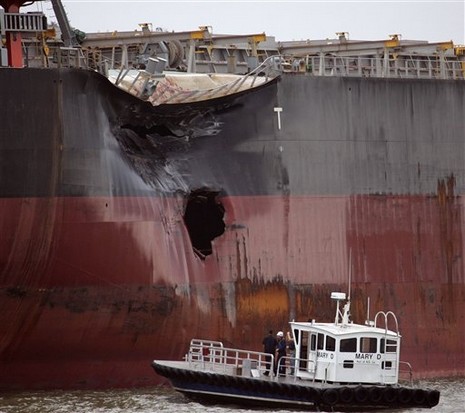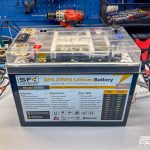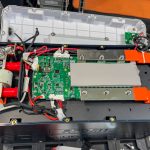Who’s driving that big rig? (#3, ouch!)

A Panbo reader (thanks, Mark!) alerted me to yesterday’s collision on the Mississippi, in which the 712’ Greek freighter Zagora, coming down river with a load of soy beans, apparently T-boned the anchored 737’ Panamanian freighter Torm Anholt. Mark wrote, “It is amazing that yet again two ships of this size are able to hit each other. And to think one of them was anchored. How is it that small vessels are not plowed under more frequently? Looking forward to class B AIS transponders.”
I’m looking forward to Class B too, but we should all be very careful not to over estimate its value. Interestingly, another Panbo reader (thanks, Kurt!) linked me to a page of presentations given at the recent AIS/06 conference. There’s a lot of interesting material there, which I’ve only skipped through, but of particular note is the first day presentation by Dr. Andy Norris. One of his conclusions is that “Class B users must not assume that their AIS signal will be visible on any ship.” More on Dr. Norris’s work to come.
And some day the National Transportation Safety Board will issue a report on the Zagora/Torm Anholt collision. NTSB reports don’t seem quite as detailed as the MAIB work I’ve referenced before, but it will be interesting to see what happened on the big River yesterday afternoon.













I don’t know Ben…that picture has an odd look about it.
I certainly agree with the comments about not assuming a big ship has seen you. This holds true regardless of the devices or aids used to attract attention.
To me, the real value of AIS is in allowing me to obtain a detailed awareness of large vessel traffic patterns so that I can better keep my wee sailboat out of harm’s way.
This collision once again illustrates how sailors, and ship’s masters have dropped the ball on basic watch keeping regardless of all the sophisticated collision avoidance equipment.
Perhaps the only collision avoidance equipment which would wake up these sleeping sailors is a super loud siren and flashing strobe going off all through the vessel and on deck so that any human being would be alerted. Forget the beep beep beep from your raymrine guard zone. This is NOT waking up sleeping seaman.. or those who have ducked into the head for a read.
Seeing such INCOMPETANCE should scare the living daylights out of anyone out there. And this goes on all the time…Like when two ferries from the same company did a head on in Plum Gut a few years ago.
I tell the following true story about how dangerous all the new interconnected technology can be. Read on.
Several years ago I was fortunate enough to have the time to live and sail alone and with occasional friends in the Caribbean.
One mid week day I decided to sail from English Harbor, Antigua to Deshais, Guadaloupe. This is about 55 miles I recall. I set out early to do the sail in day light. Set a waypoint, engaged the autopilot and off I was a lovely reach. Not a boat around.
Mid day I went below to prepare lunch… I figured I would make some pasta so I was down there for a while doing sauce and so on and with no vessels in sight when I went below I had a false sense of being alone out there.
I have a small port in my galley and as I was cooking up a storm a boat slides right past my port light maybe 20 feet to leeward. A bit closer and he would have swiped my boom!
I race to the deck to see the boat on a reciprocal course heading to Antigua. No one was in the cockpit. Was he making lunch too? And I then took my binocs and searched the horizon… kinda like looking for the horses after the barn door was opened… and lo and behold I see a nice stream of vessels ahead coming at me.. and astern following me. What the F I thought… and then it occured to me.
All the boats plugged in their way points and had departed more or less at the same time and were all on reciprocal courses.. straight as an arrow like a two lane highway (one lane more like it) in the sea. Every boat stuck to the rhumb line like a magnet all made possible by high tech electronics.
And so this rhumb line course was a series of possible collisions from Antigua to Guadaloupe.
Later I saw the same thing in Block Island Sound between Watch Hill and Block Island. Very precise very accurate.. Look ma no hands stuff and disasters waiting to happen.
Have I abandoned my auto pilot? Hell no… but I also know that I am going to be watching carefully ALL THE TIME and never going to let a GPS steer for me.
A word to the wide is supposed to sufficient.